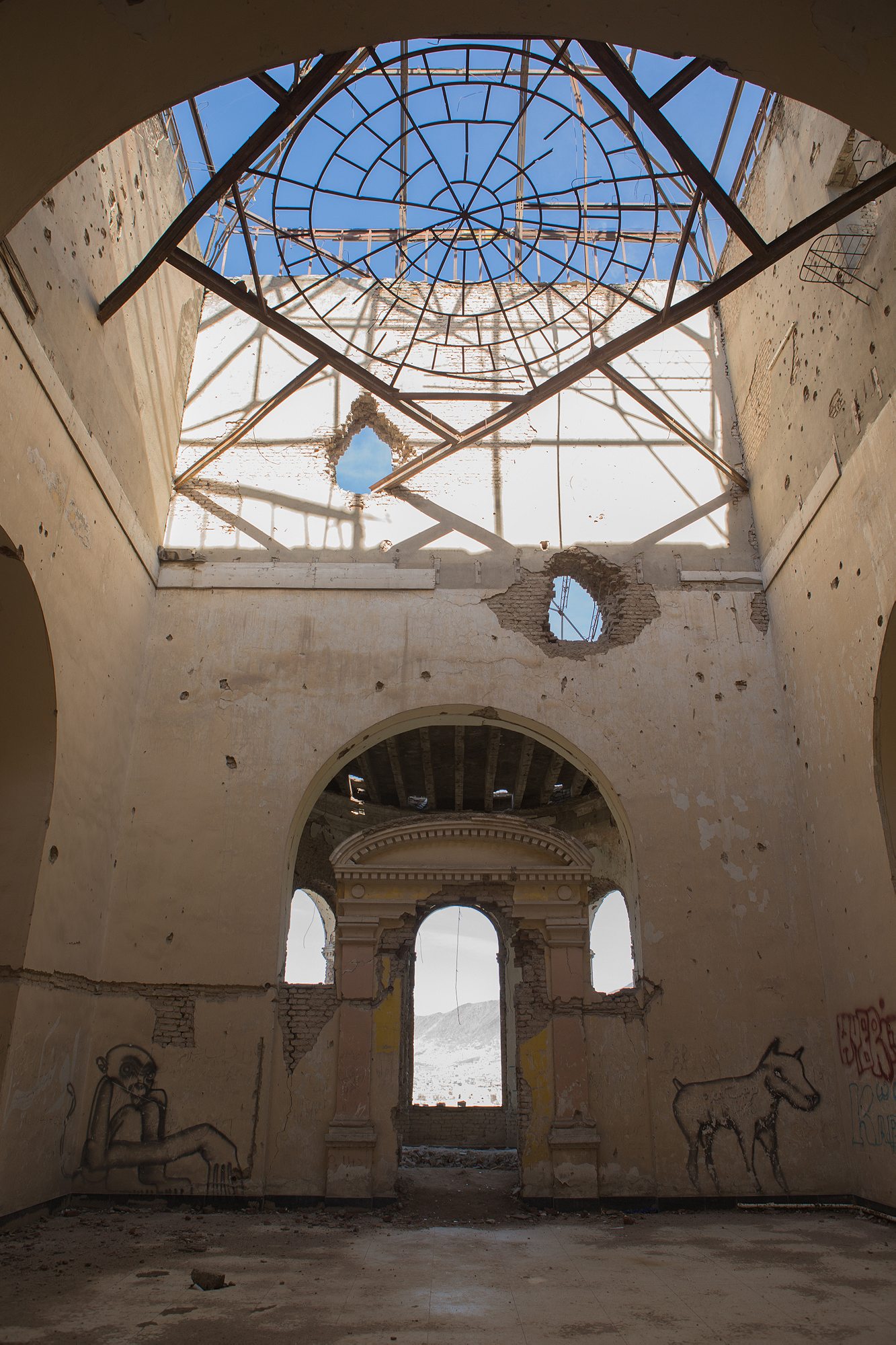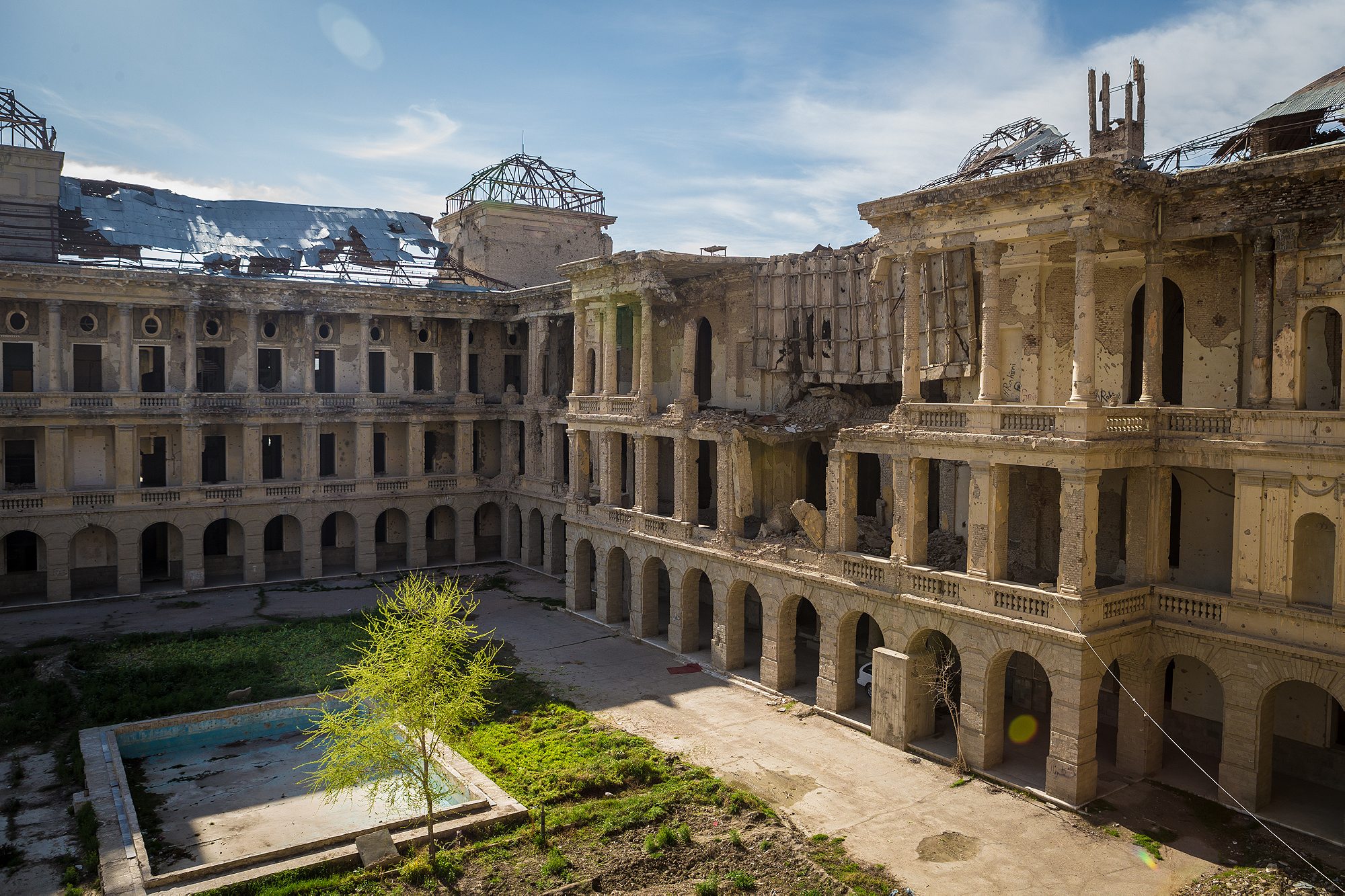In Kabul, a dispute over the future of a grand but bullet-ridden palace reflects Afghanistan’s divisions over whether to bury or memorialize its turbulent history.
KABUL, Afghanistan—
Darul Aman Palace is a magnificent structure, even in its current decrepit state. It sits on the outskirts of Kabul, Afghanistan, one of the world’s fastest-growing cities. The neoclassical building is surrounded by unkempt Venetian-style gardens, and there are several large holes in the walls, left when more than 100 delicately cast windows were blown out over the years.
The palace has become the center of a debate over the extent to which symbols of Afghanistan’s turbulent history should be preserved. “I pass this palace every day on my way to work. It hurts me to look at it,” says Hikmat Noori, a young professional from Kabul. “It is time we move forward and away from our dark days. Why should we have to relive the actions of our aggressors?”
It was once referred to as the “Versailles of Afghanistan,” built in a period when all anyone could foresee for the country was decades of economic prosperity and regional supremacy. King Amanullah Khan commissioned the palace in 1920 during a modernization spree of the country. The name Darul Aman, which literally translates to “a place for peace,” in Dari, was meant to convey the direction Afghanistan was headed in.
Nearly a century later, the palace has become a quiet testimony to the decades of war and conflict that have ravaged Afghanistan. The crumbling ruins still reflect a little of the part-European, part-Persian architecture of the original structure. Its walls bear hundreds of bullet holes, telltale reminders of the many conflicts it has seen.

It isn’t just bombs and bullets that wrecked the palace. Time has taken a toll on the building, and opportunists have taken the rest. It has been stripped of all fixtures that held any resale value in a wartime economy. Many of the exposed beams and wires have been pulled out and sold in local markets. The electrical sockets are long gone.
In 1969, a massive fire gutted the building. It was restored and became home to the country’s defense ministry, until it was attacked once again by Soviet forces during the coup d’état of 1978. A little more than a decade later, the palace became a frontline in the civil war between various Afghan warlords fighting for control of Kabul. Later, in the 1990s, it continued to deteriorate during the Taliban regime, which may not have inflicted any damage to the palace, but did nothing to preserve what remained of it either. In 2005, after the fall of the Taliban, plans were announced to turn it into a house of Parliament, but those didn’t develop and in 2012 it became a target of a resurgent Taliban.
Politicians, Afghan and foreign, have made countless empty promises about restoring the structure. Then, about three years ago, the city of Kabul announced plans to turn the palace into a restaurant. The municipality finally started construction on the restaurant last year, but was forced to stop when President Ashraf Ghani intervened. Fixing up the palace was among his many campaign promises, but many objected to the plans for an eatery.

In May, President Ghani announced the plans for a restaurant had been dropped, but the palace would still be restored. A budget of $16.5 million had already been approved by Parliament. As a sign of his commitment to the project, Ghani moved his Cabinet to the ruins for a day. Ministers held their meetings amid crumbling walls and unsteady pillars. “We are returning to our past… to set the foundation for our future,” the President said at the time. The government announced that the refurbished palace would draw tourists and host diplomatic events.
But the city is divided over the renovation. The palace has come to symbolize years of struggle, wars, and internal conflicts, and some see this restoration as an attempt to gloss over the building’s troubled history. “Preserve it the way it is. Make it safe, but keep the ruins complete with the war wounds,” says Omaid Sharifi, a civil rights activist. “The younger generation of Afghans must be able to see what war did to this country, and how we Afghans destroyed our own land,” Sharifi says, referring to the civil war in the 1990s, during which the city of Kabul was caught between warring factions.
Many of those factions are now integrated into the government. “In fact, why don’t we ask these former jihadis to raise funds?” says Sharifi. He is also part of a group of art activists calling themselves Art Lords, a play on the English word warlords. They’ve come up with a graffiti campaign called “Healing Afghanistan” that depicts the Darul Aman Palace patched up with a Band-Aid. Group members argue that Afghans need to preserve their history, rather than build over it.

Restoration will be no simple feat. Few of the original blueprints survive. Though the government of Afghanistan was able to procure more than 1,500 images and layouts of the palace from France. But there are concerns over how much of the original building will be left after the renovation.
The city insists that the palace is so unstable that it has to be substantially rebuilt – part of the structure collapsed during an earthquake last autumn. “If left in its current state, the structure will crumble away,” says Nafisa Nemati, a spokesperson at the Ministry of Urban Development. “By restoring it, we are in fact trying to preserve, not erase history. We will be reviving a form of art that was once integral to Afghanistan.”
Nemati says restoration plans include preserving some of the damage. “We will leave a small enclosure untouched, complete with its war wounds, for our children to see and understand what Afghanistan suffered through. But we must restore the rest to its former glory.”
The restoration will be as faithful to the original building as possible, Nemati says. “Every building block will come from the same quarry as the original palace,” she says. “We will also be conducting a 3D scan of the whole complex to help us preserve what we can of the original building.”
Though the Afghan government will cover all costs, the expense has also raised eyebrows. As the country continues to struggle to attain economic independence from foreign aid in light of increased security threats from the Taliban, as well as a number of groups claiming to be part of ISIS (a large part of Afghanistan’s economy is defense spending.) Many find it all wasteful. “For $16 million, they can build a new palace from scratch. Why do they need to spend it on Darul Aman Palace?” asks activist Sharifi.
Sharifi would prefer that the palace be preserved, a reminder of what the country suffered. “It is an embodiment of our struggles. It is not the legacy of any one man, but of a collective generation. This could be a beautiful and important museum of war.”
